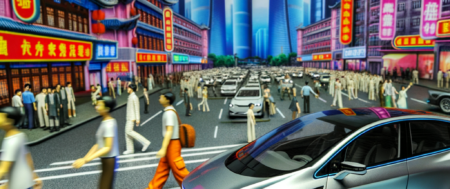TL;DR: In the world’s largest automotive market, China, both domestic car brands and foreign automakers are thriving amidst fierce market competition, driven by a growing economy, urbanization, and an expanding middle class. The surge in demand for Electric Vehicles (EVs) and New Energy Vehicles (NEVs), supported by government incentives to address environmental concerns, highlights the shift towards green technology. Navigating the complex regulatory landscape through joint ventures and strategic partnerships is key for foreign companies to access this vast market. Success hinges on adapting to consumer preferences, leveraging technological advancements, and understanding the regulatory environment, making the Chinese automotive sector a challenging yet rewarding arena for all players.
In the fast-paced world of the automotive industry, the spotlight shines brightest on China, home to the largest automotive market on the globe. This dynamic market, fueled by a rapidly growing economy and the relentless wave of urbanization, has emerged as the epicenter of automotive innovation and sales. China’s voracious appetite for both domestic car brands and foreign automakers‘ latest models is reshaping the global automotive landscape. With a keen focus on Electric Vehicles (EVs) and New Energy Vehicles (NEVs), spurred by significant government incentives and mounting environmental concerns, China is steering towards a greener, more sustainable future on the roads.
Navigating this colossal market requires a deep dive into the intricacies of its regulatory landscape, a clear understanding of the strategic partnerships that power these automotive ventures, and an acute awareness of the ever-evolving consumer preferences that dictate market trends. From the bustling streets of its mega-cities to its rapidly expanding urban fringes, China’s automotive market is a complex, competitive arena where technological advancements, government policies, and market competition converge to drive innovation at an unprecedented pace.
As foreign automakers forge joint ventures with local Chinese companies to gain a foothold in this lucrative market, they face a regulatory framework that is as challenging as it is rewarding. These collaborations are crucial for tapping into China’s extensive consumer base and meeting the specific tastes and environmental expectations of Chinese drivers. This article aims to unpack the multifaceted nature of China’s automotive sector, exploring how its growing economy, urbanization, and consumer demand for EVs and NEVs are propelling the country to the forefront of the automotive world. With a lens on the strategic partnerships, regulatory challenges, and the competitive landscape, we delve into what makes China the driving force behind the future of mobility. Join us as we explore the lanes of innovation, competition, and collaboration that define the largest automotive market in the world.
1. **Navigating the Terrain: Understanding the Regulatory Landscape and Strategic Partnerships in China’s Largest Automotive Market**

Navigating the terrain of China’s automotive sector, the world’s largest automotive market, requires a nuanced understanding of its regulatory landscape and the strategic partnerships that are critical for success. This market’s dynamism is fueled by a combination of factors including a growing economy, rapid urbanization, and an expanding middle class with evolving consumer preferences. These elements together have propelled demand for both domestic car brands and international names, with a notable surge in interest for Electric Vehicles (EVs) and New Energy Vehicles (NEVs).
The push towards EVs and NEVs is significantly driven by government incentives aimed at addressing environmental concerns and positioning China as a leader in green technology. This aligns with the broader global trend towards sustainability but is particularly pronounced in China due to its severe pollution challenges. The government’s role in the automotive industry extends beyond incentives for cleaner vehicles; it has crafted a complex regulatory landscape that all players must navigate. Foreign automakers, in particular, face a unique set of challenges and opportunities in this environment. To access China’s vast consumer base, they often enter into joint ventures with local companies. These strategic partnerships are not merely a regulatory compliance measure but a critical strategy for sharing resources, knowledge, and networks. They enable foreign brands to gain insights into consumer preferences, which can vary significantly from those in other markets, and to adapt their offerings accordingly.
Technological advancements are another pivotal aspect of China’s automotive market. The rapid pace of innovation in the country, particularly in digital technologies, is reshaping how vehicles are manufactured, marketed, and used. Companies operating in this space must stay at the forefront of technology to remain competitive, leveraging advancements not just in vehicle design and manufacturing but also in areas like artificial intelligence and data analytics for consumer research and marketing.
The competitive landscape in China’s automotive market is intense, with domestic brands increasingly vying with foreign automakers for market share. This competition, while challenging, fosters an environment of continuous improvement and innovation, benefiting consumers and pushing the industry forward. Strategic partnerships between local and international players have become a vital aspect of navigating the market’s complexities, enabling companies to leverage each other’s strengths and address the unique demands of Chinese consumers.
Understanding and adapting to the regulatory landscape, forming strategic partnerships, and staying abreast of technological advancements and consumer preferences are all crucial for success in China’s automotive market. With its position as the largest automotive market globally, China offers immense opportunities for both domestic and foreign companies. However, tapping into this market requires a deep understanding of its unique characteristics and challenges, making it a highly dynamic but rewarding arena for the automotive industry.
In conclusion, the journey through China’s automotive sector, the world’s top and largest automotive market, reveals a landscape as dynamic and complex as the country’s burgeoning cities. With its growing economy fueling an ever-expanding middle class and rapid urbanization, China has positioned itself as a formidable force in the global automotive industry. The market’s appetite spans from domestic car brands to foreign automakers, with electric vehicles (EVs) and new energy vehicles (NEVs) steering the future of mobility in the country, thanks to significant government incentives and mounting environmental concerns.
Foreign companies eyeing success within this competitive arena find themselves navigating a maze of regulatory landscapes, which often leads to forming joint ventures with local Chinese counterparts. These strategic partnerships are not just a means to an end but a necessary blueprint for accessing China’s vast consumer base while adhering to its unique market demands and government policies.
The rise of EVs and NEVs underscores the market’s shift towards sustainability, driven by technological advancements and consumer preferences that lean heavily towards environmentally friendly options. This shift is further amplified by China’s government incentives, aimed at reducing the country’s carbon footprint and establishing it as a leader in green technology.
However, the road ahead is not without its challenges. Companies must stay agile, continuously adapting to the latest market trends, technological advancements, and changes in consumer behavior. The ability to understand and leverage the regulatory landscape, maintain robust strategic partnerships, and meet the evolving demands of Chinese consumers will distinguish the leaders in this highly competitive and ever-changing market.
As China’s automotive industry motors ahead, fueled by a growing economy, urbanization, and a clear pivot towards electric and new energy vehicles, its influence on the global stage is set to accelerate. Navigating this market requires a deep understanding of its complexities, from joint ventures and strategic partnerships to aligning with government incentives and addressing environmental concerns. For foreign and domestic automakers alike, success in China’s automotive market hinges on their ability to adapt, innovate, and resonate with a diverse and dynamic consumer base, making it an exhilarating time for the automotive world.






